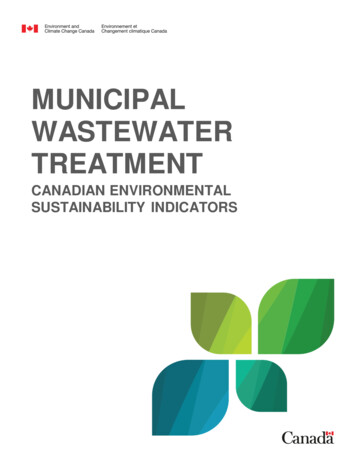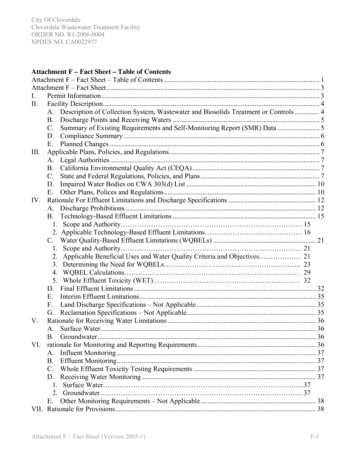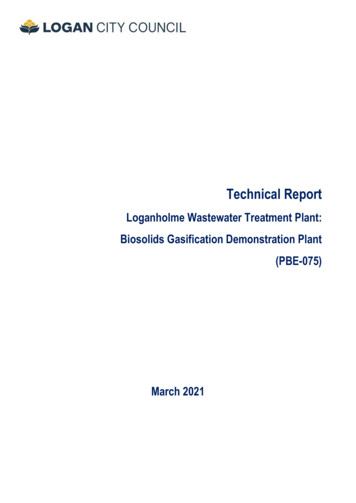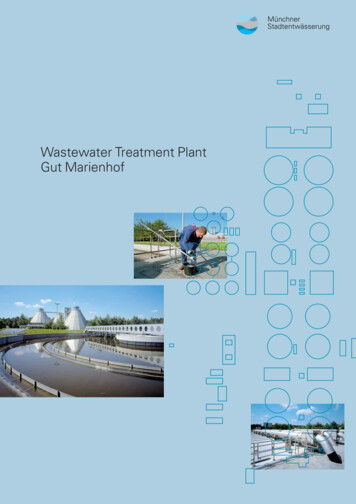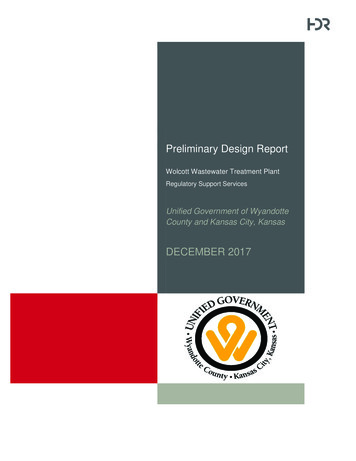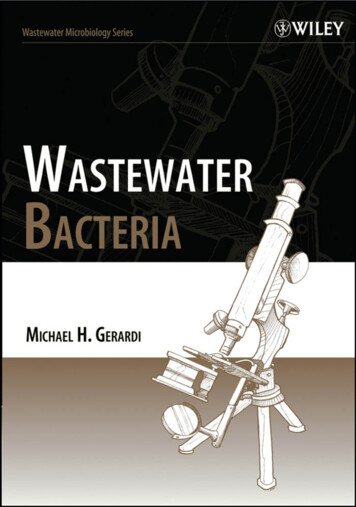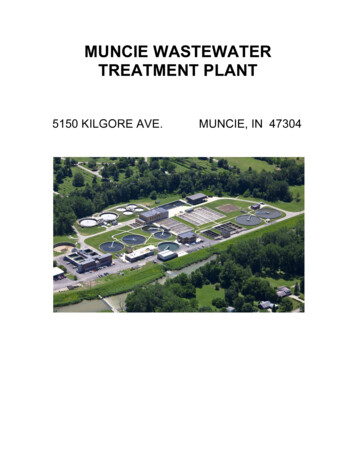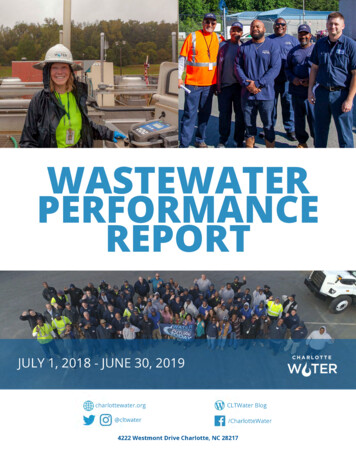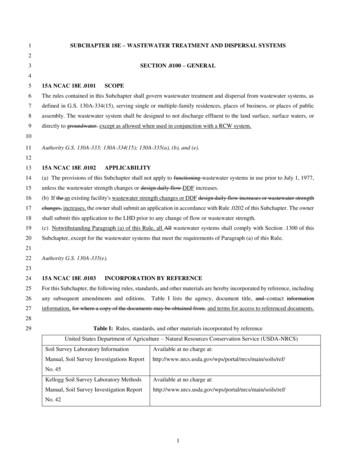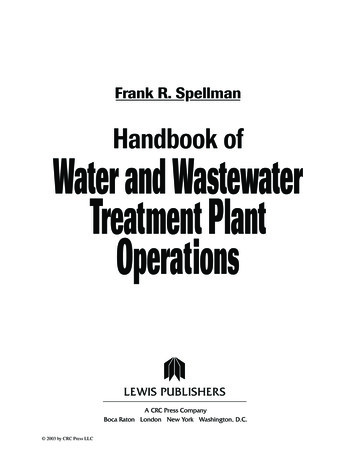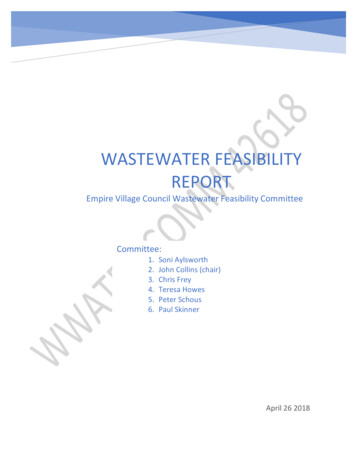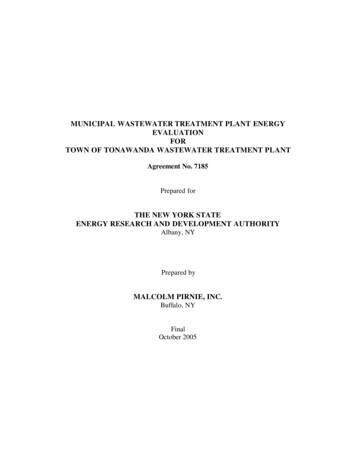
Transcription
MUNICIPAL WASTEWATER TREATMENT PLANT ENERGYEVALUATIONFORTOWN OF TONAWANDA WASTEWATER TREATMENT PLANTAgreement No. 7185Prepared forTHE NEW YORK STATEENERGY RESEARCH AND DEVELOPMENT AUTHORITYAlbany, NYPrepared byMALCOLM PIRNIE, INC.Buffalo, NYFinalOctober 2005
TABLE OF CONTENTSSectionPage1INTRODUCTION . 1-11.1Overall Project Description . 1-11.2Facility Background . 1-11.3Scope and Objectives . 1-21.3.1Review of Historical Plant Performance and Energy Usage Data. 1-21.3.2Electric Submetering. 1-31.3.3Identification of Energy Saving Opportunities throughEquipment Replacement or Modification. 1-41.3.4Identification of Energy Savings Opportunities throughOperational Changes . 1-42CURRENT AND HISTORICAL OPERATIONS. 2-12.1Existing Treatment Processes . 2-12.1.1Preliminary Screening. 2-12.1.2Influent Wastewater Pumping . 2-12.1.3Aerated Grit Removal. 2-12.1.4Secondary Treatment . 2-12.1.5Solids Contact Clarification. 2-22.1.6Tertiary Sand Filtration . 2-22.1.7Chlorine Disinfection. 2-22.1.8Solids Handling. 2-32.2Historical Energy Usage and Utility Billing. 2-42.3Natural Gas Summary . 2-42.4Summary of Energy Costs . 2-52.5Summary of Historical Loadings and Effluent Quality. 2-53ELECTRIC SUBMETERING PROGRAM. 3-13.1Description of Submetering Program and Submeter Locations. 3-13.1.1Description of Program. 3-13.1.2Submeter Locations. 3-13.2Summary of Site Audit . 3-23.3Summary of Continuous Submetering. 3-23.3.1High Pressure Service Water Pump . 3-23.3.2Influent Wastewater Pumps. 3-33.3.3Incinerator Induced Draft Fan. 3-43.3.4Zimpro Motor Control Feeders . 3-43.3.5Zimpro Fume Fan . 3-53.4Summary of Instantaneous Submetering. 3-53.5Summary of Entire Submetering Program. 3-64PROCESS PERFORMANCE DURING SUBMETERING. 4-14.1Summary of Process Parameter Monitoring . 4-14.2Relationship between Plant Process Data and Submetering Data. 4-24.2.1Main Influent Wastewater Pumps. 4-24.2.2High Pressure Service Water Pumps . 4-34.2.3High Purity Oxygen Reactor (UNOX). 4-32255-063NYSERDA SubmeteringiWastewater Treatment PlantTown of Tonawanda
TABLE OF CONTENTS 24.2.6.34.2.6.44.2.7Return Activated Sludge Pumps . 4-3Monomedia Filtration. 4-4Solids Handling. 4-4Waste Activated Sludge/Thickening . 4-4Zimpro Wet Air Oxidation . 4-5Vacuum Filtration. 4-5Incinerator and Associated Solids Handling Equipment. 4-5Other Equipment . 4-65ENERGY SAVING MEASURES THROUGH CAPITAL IMPROVEMENTS. 5-15.1Capital Improvement Alternatives to Reduce Energy Usage and Costs . 5-15.1.1Replacement of Existing Sludge Stabilization and Dewatering Facilitieswith High Speed Dewatering Centrifuges . 5-15.1.2Modification or Replacement of UNOX Mixers with More EfficientMixing Equipment. 5-25.1.3Replacement of Existing Cryogenic Oxygen Generation System withVacuum-Assisted Pressure Swing Adsorption Technology . 5-25.1.4High Pressure Service Water Pump Modifications . 5-35.1.5Replacement of Constant Speed Standard Efficiency Motors withPremium Efficiency Motors . 5-35.2Estimate of Energy Usage, Demand, and Cost Savings . 5-45.2.1Replacement of Existing Sludge Stabilization and Dewatering Facilitieswith High Speed Dewatering Centrifuges . 5-45.2.2Modification or Replacement of UNOX Mixers with More EfficientMixing Equipment. 5-55.2.3Replacement of Existing Cryogenic Oxygen Generation System withVacuum-Assisted Pressure Swing Adsorption Technology. 5-65.2.4High Pressure Service Water Pump Modifications . 5-75.2.5Replacement of Constant Speed Standard Efficiency Motors withPremium Efficiency Motors . 5-95.3Estimate of Capital Costs and Simple Payback. 5-95.3.1Replacement of Existing Sludge Stabilization and Dewatering Facilitieswith High Speed Dewatering Centrifuges . 5-95.3.2Modification or Replacement of UNOX Mixers with More EfficientMixing Equipment. 5-105.3.3Replacement of Existing Cryogenic Oxygen Generation System withVacuum-Assisted Pressure Swing Adsorption Technology. 5-115.3.4High Pressure Service Water Pump Modifications . 5-115.3.5Replacement of Constant Speed Standard Efficiency Motors withPremium Efficiency Motors . 5-126ENERGY SAVING MEASURES THROUGH OPERATION MODIFICATIONS . 6-16.1Operational Modifications to Reduce Energy Usage and Costs . 6-16.1.1Load Shifting . 6-16.1.2Operational Modifications. 6-27ENERGY SAVING MEASURES THROUGH LIGHTING/HVAC MODIFICATIONS. 7-17.1Overview. 7-12255-063NYSERDA SubmeteringiiWastewater Treatment PlantTown of Tonawanda
TABLE OF CONTENTS (continued)SectionPage7.287.1.1Heating, Ventilating, and Air Conditioning Overview. 7-17.1.2Lighting Overview. 7-1HVAC and Lighting Alternatives to Reduce Energy Usage and Costs. 7-17.2.1HVAC. 7-17.2.2Lighting . 7-2FINAL RECOMMENDATIONS. 8-18.1Summary of Evaluations. 8-18.2Summary of Recommendations. 8-1TABLESTableOn/Follows Page2-12-22-3Summary of Energy Costs. 2-5Summary of WWTP Performance – Wet Stream Process. 2-6Summary of WWTP Performance – Solids Handling Processes . 2-73-13-23-33-43-5List of Motors Over 5 hp. 3-1Summary of Influent Pumps during the Submetering Period. 3-3Instantaneous Power Draw Measurement and Estimates of Hours in Operation. 3-6Estimates of Electric Energy Usage and Costs . 3-6Summary of Major Equipment Total Estimated Electric Energy Usage and Costsat the WWTP . 3-74-1Summary of Town of Tonawanda WWTP Performance during the Submetering PeriodCompared to Historical Data. 4-25-15-25-7Estimated Post-Construction Electric Energy Profile Summary for Centrifuge Equipment. 5-5Summary of Estimated Electric Energy Usage and Savings for Stabilization/DewateringSystem Replacement. 5-5Oxygen Transfer and Mixing Requirements. 5-5Summary of Estimated Electric Energy Usage and Savings for UNOX Mixer Replacement. 5-6Summary of Estimated Electric Energy Usage and Savings for Oxygen GenerationSystem Replacement. 5-7Summary of Estimated Electric Energy Usage and Savings for High Pressure ServiceWater Pump Modifications. 5-9Replacement of Select Motors with Premium Efficiency Motors. 5-97-17-2Summary of Costs and Savings for HVAC Measures . 7-2Summary of Costs and Savings for all Lighting Measures. 7-28-18-2Summary of Energy Savings Alternatives Presented in Sections 5, 6 and 7. 8-1Summary of Recommended Alternatives. 8-25-35-45-55-62255-063NYSERDA SubmeteringiiiWastewater Treatment PlantTown of Tonawanda
TABLE OF CONTENTS (continued)FIGURESFigureFollows Page2-12-22-32-42-52-62-72-82-92-102-11WWTP Wet Stream Process Train . 2-1Solids Handling Process Train . 2-1Electric Demand and Usage. 2-4Change in Demand (2001 to 2003). 2-4Change in Electric Usage (2002 to 2003). 2-4Total Plant Hourly kW Draw. 2-4Natural Gas Usage (2002 to 2003) . 2-4Influent TSS and BOD Loading . 2-6Electric Demand vs. Average Plant Flow. 2-6Electric Usage vs. Average Plant Flow. 2-6Natural Gas Usage vs. Average Plant Flow. 2-63-13-23-33-43-53-63-73-8Overall Plant Electric Demand . 3-2Submetering – High Pressure Service Water Pump . 3-2Submetering – Influent Pumps. 3-3Submetering – Induced Draft Fan. 3-4Submetering – Zimpro Motor Control Center Feeders . 3-4Submetering – Zimpro Fume Fan. 3-5Distribution of Electric Energy Cost Among Processes . 3-7Distribution of Electric Usage Among Solids Handling Processes. 3-84-14-24-34-44-54-64-74-8Submetering – BOD5 vs. Flow. 4-1Submetering – BOD5 Loading vs. Flow. 4-1Submetering – TSS vs. Flow. 4-1Submetering – TSS Loading vs. Flow. 4-1Average Daily Flow vs. Total Electric Energy Demand by Main Influent Pumps . 4-2Service Water vs. Total Electric Energy Demand by High Pressure Service Pumps. 4-3Thickened Sludge Inflow to Zimpro vs. Zimpro System Energy Demand. 4-5Submetering – Zimpro Operation. 4-55-1High Pressure Service Pump Curves . 5-72255-063NYSERDA SubmeteringivWastewater Treatment PlantTown of Tonawanda
Section 1.0INTRODUCTION1.1OVERALL PROJECT DESCRIPTIONThe New York State Energy Research and Development Authority (NYSERDA) is currently sponsoring aresearch program to evaluate submetering at wastewater treatment plants (WWTPs) throughout New YorkState. The purpose of monitoring is to obtain detailed electric power use information through submeteringvarious unit processes and equipment and to determine if that information is a cost-effective tool foridentifying energy conservation measures. In addition to evaluating the usefulness of submetering, asecondary goal of the program is to identify and evaluate energy cost savings measures at WWTPs andmake the findings available to other facilities in New York State.1.2FACILITY BACKGROUNDThe Town of Tonawanda Wastewater Treatment Plant (WWTP) receives wastewater flow from theseparate sanitary sewer system serving the Town, as well as from two tributary communities: the Village ofKenmore and the City of Tonawanda. The Tonawanda WWTP is an advanced tertiary treatment facilitythat handles an average dry weather wastewater flow of 19.7 millions per day (MGD). Wet weather flowsto the WWTP can peak as high as 75 to 80 MGD.The Tonawanda WWTP is a SC-3A customer. Transmission is at 23,000 volts and is stepped down at themain plant transformer to 4,160 volts (V). Five out of the six 4,160 V lines coming out of the main planttransformer that serve the main plant are stepped-down further to fifteen 480 V lines that serve individualmotor control centers. One 4,160 V service provided to the main plant is not stepped down and serves thecryogenic oxygen generation facility for the plant’s UNOX process. Two additional 4,160 V lines areprovided from the main plant transformer to a step-down transformer adjacent to the solids handlingbuilding. These lines are further stepped-down to 240 V to serve various applications at the solids handlingbuilding.Totalizer submetering is conducted at various locations in the plant’s electrical system. These locationsinclude the main electrical feed to the plant, six 4,160 V lines serving the main plant and two 240 V linesserving the solids handling building. Component level submetering is not conducted at the plant. Presently,the facility does not have a stand-by generator. However, the Town is planning to install a 2.0 Megawatt(MW) generator to provide stand-by power for the entire facility in 2005.2255-063NYSERDA FlexTech Services1-1Town of TonawandaWastewater Treatment PlantSubmetering
The treatment processes at the WWTP include the following: Preliminary treatment, including mechanically cleaned bar screens and aerated grit removal Secondary biological treatment using high purity oxygen reactors (UNOX), bio-clarifiers andsolids contact clarifiers Tertiary treatment using monomedia filters Disinfection using chlorine gas Solids handling consisting of sludge thickening, sludge stabilization using Zimpro, dewateringusing vacuum filters, and on-site incinerationA more detailed description of the Tonawanda treatment processes is presented in Section 2.0 of this report.1.3SCOPE AND OBJECTIVESThis study involved the following activities as part of the overall electric and natural gas use assessmentand electric submetering program.1.3.1Review of Historical Plant Performance and Energy Use DataData were obtained from the WWTP to establish a baseline for plant performance and energy usage at theTown of Tonawanda WWTP. The baseline seeks to separate improvements related to power savings fromthose that result from exogenous effects, such as changes in influent water quality, seasonal, and weeklycycles, and/or energy market changes.Data obtained from the Town’s WWTP included: Average, minimum, and maximum daily flow. Influent and final effluent total suspended solids (TSS) and biochemical oxygen demand (BOD). Mixed liquor suspended solids (MLSS). Return activated sludge (RAS) flow and TSS. Waste activated sludge (WAS) flow. Thickened sludge quantities and TSS concentration; thickened sludge pump operating records. Zimpro effluent TSS and volatile suspended solids (VSS) Vacuum filter operating records (number of units in operation, operating hours, sludge quantitiesand solids percentage) Incinerator operating records (number of units in operation, operating hours, sludge quantities andsolids percentage). Plant service water flows and pressures, plant water pump operating records. Oxygen generation data (quantity and purity).2255-063NYSERDA FlexTech Services1-2Town of TonawandaWastewater Treatment PlantSubmetering
Historical energy usage, including available metered data, two years of utility bills, and anyprocess changes recently undertaken or contemplated. Recent energy consumption data for non-electric accounts, including natural gas. Preventive and corrective maintenance records.1.3.2Electric SubmeteringContinuous submetering and instantaneous power draw measurements were completed to assess the typicalelectric usage of some of the larger motors (greater than 5 hp) at the WWTP. Continuous submeteringlocations were selected based on the information gained during the site energy audit so that the larger andmost energy-intensive motors could be metered. Instantaneous power draw measurements were alsoobtained on additional motors, particularly those that operated on a set schedule at a constant speed.The continuous submetering data were used to capture diurnal variations in electric demand for majorpieces of equipment, as well as to provide a representative sample of energy usage, including electricdemand, as equipment cycles on and off. The following data were recorded at each location: Load factor Power factor Demand (kW) Usage (kWh)Instantaneous submetering was conducted during a one-day site visit and the data were used to verifyexpected energy demand at the treatment plant, as well as monitor changes in demand as equipment iscycled on and off.In addition, process data were collected for the duration of the submetering period including: Service water pressure and flow. Service water pump operating hours. Sludge pump operating records (on and off times for WAS, RAS, and thickened sludge pump inoperation). Zimpro and vacuum filter equipment on and off time. Oxygen purity and quantity. Vent gas purity. Diurnal BOD concentrations on a bi-hourly basis for a two-day duration.The process data collected were used to correlate electric energy usage to equipment operation and processperformance, and to evaluate energy savings opportunities through equipment replacement or modification2255-063NYSERDA FlexTech Services1-3Town of TonawandaWastewater Treatment PlantSubmetering
(Task 4) and through operational changes (Task 5). The data will also be used to establish basic energyperformance measures (metrics) for comparison of energy usage at the Town of Tonawanda WWTP to thatof other WWTPs in New York State.1.3.3Identification of Energy Saving Opportunities through Equipment Replacement orModificationEnergy savings opportunities resulting from equipment replacement and/or process modification wereidentified based on review of the submetering data. Some of these opportunities, while they may consumemore energy than existing process, may also serve to improve treatment at the plant, thereby savingoperational dollars in the plant’s overall budget.1.3.4Identification of Energy Savings Opportunities through Operational ChangesThe submetering data were further reviewed to assess the impact of demand throughout the course of theday and examined for energy saving opportunities through load shifting, peak shaving, and greater use ofreal-time data in energy-related decision-making.Load shifting would involve changing the time of use of certain loads to reduce the total facility demandduring peak periods in an attempt to reduce demand charges. Load shifting opportunities were evaluatedfor major equipment. Peak shaving is the practice of dispatching on-site generating assets to reducedependence on the grid during peak demand periods. However, because Tonawanda currently does nothave on-site generation capabilities, peak shaving opportunities were not evaluated as part of this study.This report summarizes the data evaluation and offers recommendations for opportunities to reduce energyusage and thereby reduce costs at the Town of Tonawanda WWTP.2255-063NYSERDA FlexTech Services1-4Town of TonawandaWastewater Treatment PlantSubmetering
Section 2.0CURRENT AND HISTORICAL OPERATIONSThis section presents a brief description of the existing treatment processes at the Town of TonawandaWastewater Treatment Plant (WWTP), historical implementation of energy saving measures and theresulting effect on effluent quality.2.1EXISTING TREATMENT PROCESSESFIGURES 2-1 and 2-2 present the process flow diagram for the wet stream process train and the solidshandling process train at the Tonawanda WWTP, respectively. A brief description of the unit treatmentprocesses that are currently employed at the plant is presented below.2.1.1Preliminary ScreeningPreliminary screening at the Tonawanda facility is accomplished through the use of three mechanicallycleaned bar screens, which remove large material and debris from the wastewater flow.2.1.2Influent Wastewater PumpingInfluent flow enters the wet well and is lifted to the grit chamber influent channel by four 125 hpcentrifugal pumps. Screened and metered flow from the City of Tonawanda enters the plant at the gritchamber influent channel.2.1.3Aerated Grit RemovalTwo parallel, aerated grit chambers, operating continuously, remove sand and grit from the influentwastewater. A 75 hp blower supplies air to the aerated grit chambers. Captured grit is hauled to a landfillsite. Flows in excess of 40 MGD are bypassed around the grit chambers because of hydraulic limitations inthe approach channel.2.1.4Secondary TreatmentEffluent from the grit chambers is distributed among four treatment modules, each consisting of a highpurity oxygen reactor (UNOX), secondary bio-clarifier, and solids contact clarifier. Grit chamber effluentis mixed with oxygen and return activated sludge (RAS) from the bio-clarifiers as it enters the first stage ofthe reactor. The UNOX system has four covered reactors and each reactor has four stages (Stages Athrough D). Each stage is equipped with an impeller mixer that agitates and entrains oxygen from theheadspace into the mixed liquor. Each reactor has one 40/22 hp two speed mixer (Stage A), one 30/17 hptwo-speed mixer (Stage B) and two 20 hp one-speed (Stages C and D) mixers.2255-063NYSERDA FlexTech Services2-1Town of TonawandaWastewater Treatment PlantSubmetering
City InfluentKenTon InfluentSawyer InfluentDistrict 5 InfluentBar ScreensMainPumpsAerated GritChamberHigh-Purity OxygenActivated SludgeBioreac
NYSERDA FlexTech Services Wastewater Treatment Plant Submetering Section 1.0 INTRODUCTION 1.1 OVERALL PROJECT DESCRIPTION The New York State Energy Research and Development Authority (NYS ERDA) is currently sponsoring a research program to evaluate submetering at wastew ater treatment plants (WWTPs) throughout New York State.
